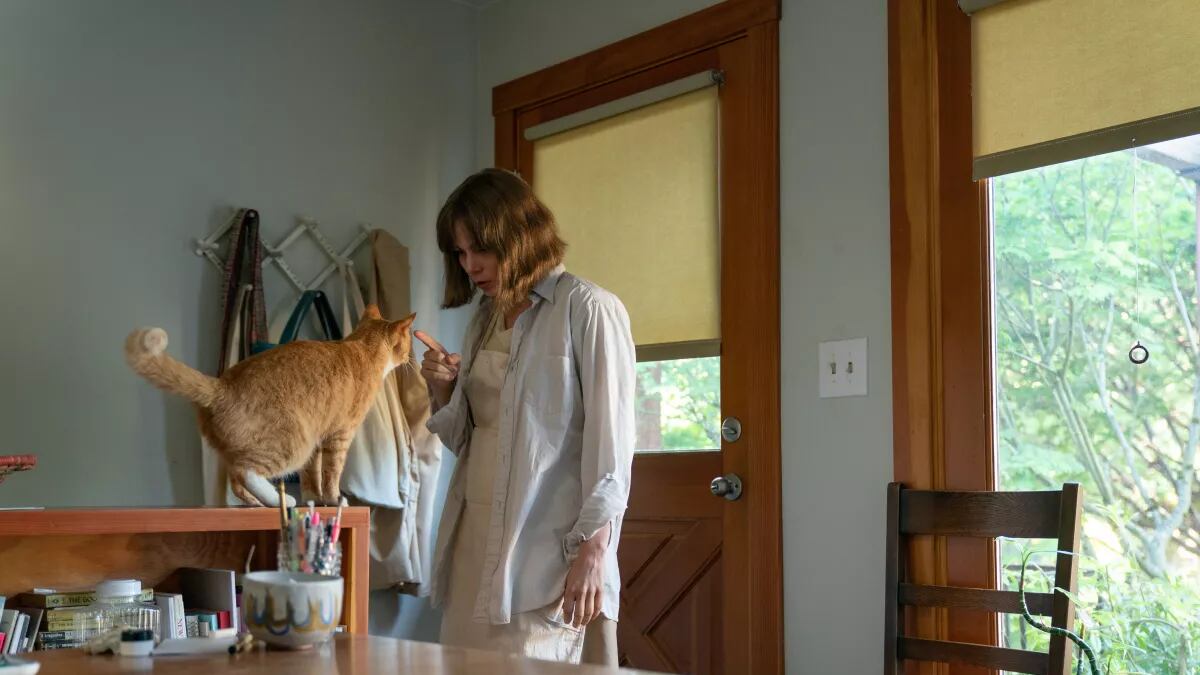In the climactic scene of director Kelly Reichardt’s Showing Up, an injured pigeon takes flight in an art gallery. It’s a perfect metaphor for the unlikely sense of liberation that the film’s frazzled, frustrated characters experience—and it’s based on an incident from co-writer Jon Raymond’s life.
Raymond, an Oregon Book Award-winning author, has made even more movies with Reichardt than her longtime muse, Michelle Williams. The pair have collaborated on both adaptations of Raymond’s writing (Old Joy, First Cow) and original screenplays (Wendy and Lucy, Meek’s Cutoff, Night Moves).
Showing Up, a Portland-filmed dissection of the fraying bond between sculpturist Lizzy (Williams) and her landlord and fellow artist Jo (Hong Chau), is another original creation. Like all of Reichardt’s films, it is a movingly attentive look at the nuances of human interaction, chronicling the hectic days leading up to a showcase of Lizzy’s sculptures (which were created by Portland artist Cynthia Lahti).
On Thursday, Raymond will interview Tom Hanks about his novel, The Making of Another Major Motion Picture Masterpiece. As his encounter with the actor loomed, Raymond looked back at Showing Up, explaining how he and Reichardt divided up their screenwriting duties—and how the time he thought he was “a bad person” helped inspire the film.
WW: Tell me about the origins of Showing Up.
Jon Raymond: The political climate [in the Trump era] was so toxic and horrible that personally, I was wanting to do something where we got to think about something we liked. The politics of the time were so obvious and brutal that doing something about any of that stuff just seemed pointless. I like visual art. Kelly likes visual art. Being 50ish, I felt like I had something to say about the psychodrama of bringing art into the world.
The film captures the landlord-tenant relationship with so much realism and discomfort…
It’s weirdly so rare in movies to see people or situations that bear any resemblance to real life. It becomes a funny litmus test. Some friends of mine are like, “God, Jo is such an asshole. What a horrible landlord.” And other people are like, “She seems like a normal person, a little into her own thing, but it’s not crazy.” It’s just funny how people map their own emotional things onto [Lizzy and Jo].
The now-closed Oregon College of Art and Craft, where Showing Up was filmed, feels very much like a character in the film.
I grew up around here and I have very distant memories of being a young kid going there. They used to do Sunday brunch, where the students would become waiters. Not only does it have a very unique, beautiful architectural environment, but it also seemed like an opportunity to commemorate this kind of institution that is so endangered now. A groovy little art school is increasingly implausible.
Can you describe your collaboration with Kelly?
Generally, I’ll come up with the idea and then I’ll write the draft or a couple drafts that establish the characters, storyline, setting, all that stuff. Kelly will offer notes, and then it’s later in the process that she will add stuff as well. I create, then she comes in and creates it better.
I remember going through almost five different memos [for Showing Up] that I wrote that were of increasing length—and very different shapes. I started out going, “Maybe it’ll be about a relational aesthetics artist who gets into a weird relationship with some collaborators.” It was finally when I put the bird into it that a skeleton [of a narrative] became apparent and I wrote an actual draft.
The gallery scene with the pigeon must have been so tricky to get right. It had to be down to earth and also have a sense of catharsis and rebirth.
That actually sort of happened to me, when I was living in North Portland in a group house over there. One night, I woke up and the cat was torturing this poor bird on our bathroom floor. I did exactly what Lizzy does—I threw it out the window: “Go die somewhere else!”
Then, at that time, this beatnik family was squatting in the backyard of our neighbor’s house—this really beautiful family with young parents and long-haired kids. I woke up in the morning and saw that they had rescued the bird. I was like, they’re good people and I’m a bad person.
It’s really a testament to Kelly’s powers that that bird never becomes too much of a symbol of anything. It sort of flirts with that, but it’s kept to being a bird, instead of a symbolic bird, I hope.
SEE IT: Jon Raymond appears in conversation with Tom Hanks at the Keller Auditorium, 222 SW Clay St., 503-248-4335, portland5.com. 7:30 pm Thursday, May 18. $30-$90.
